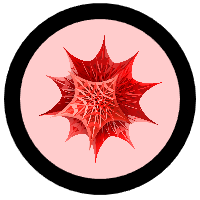Design and print a piece of three-dimensional art using Mathematica.
The final product of this project will be a piece of art that:
- Originates from some mathematical idea or concept.
Your work should have at its base some mathematical idea that interests you. You may choose to try to faithfully replicate the concept or simply use the concept as a seed in a more abstract piece. As part of this project, you will be expected to write, revise, and polish a one-page discussion of the choices you have made in designing the piece of art, from choice of topic to your decisions about the physical manifestation of your piece.
- Uses functional techniques from Mathematica.
A common theme in many pieces of Mathematical art is the use of repetition or symmetry; Mathematica excels at both. Your art should be designed to make use of these capabilites. Of great use will be the Manipulate command which will allow you to modify certain parameters of your construction in order to find an optimal* arrangement.
* So perhaps you want a definition of optimal? Your creativity comes into play here; it should allow you to bring out the quality you want the most in your project. Do you want most aestheic? least aesthetic? Smoothest? Roughest? Most proportional? Least proportional?
- Has been critiqued, refined, and revised multiple times.
We will work to improve your project at many steps. What works well in Mathematica? What doesn't? What works well when doing 3D printing? What doesn't? By refining your project through constructive criticism and through prototyping, you will be able to get the most out of your project.
- Start exploring by Monday, March 16:
Before class, get inspired! Explore some mathematical flavored blog posts, watch some mathematical videos. Take time to browse mathematical and non-mathematical art. Develop a taste for what you like. What type of mathematics can serve as a base for your art? What type of artist do you aspire to be? Comment on the discussion board with links to two or three inspiring objects.
- Prepare Project Ideas for Monday, March 23:
For this day, your idea should be getting more concrete. You should have researched the mathematical topic and started sketching on paper some of the concepts you are considering. Start a Mathematica notebook that plays around with some of these concepts. Bring your sketches and notebook to class and we'll meet in groups to brainstorm ways to improve your project. On this day, part of class will be a discussion of the limitations of 3D printing and how to use Mathematica to best represent your concept digitally.
- Project Draft on Monday, March 30:
By this date, you are expected to be have completed most of your project, including a draft of your one-page writeup. You will present your Mathematica file to the entire class for constructive criticism and their feedback. This will be the time to ask questions you might have to prepare for prototype submission.
- Prototype submission on Wednesday, April 1:
On this day, we will submit your project to Shapeways for prototyping. This deadline is important so that you can receive the physical prototype before the end of Spring Break.
- Prototype Critiquing on Monday, April 13:
Bring in your prototype to class. We will all meet and discuss what worked as planned, what didn't work as well as hoped, provide suggestions for polishing and refinement for the final submission.
- Final Submission on Friday, April 17:
You should have refined your project and submitted it for printing at Shapeways.
- Field Trip on Friday, April 29:
We will meet at Shapeways at 9:00am for a factory tour!
This project represents 20% of your semester grade. You will be graded on how well your project addresses the specifications laid out above, and on your presentation of your notebook. You are expected to arrive on time and make comments on your classmates' presentations and projects. If you are late or absent, this will negatively affect your own grade.
